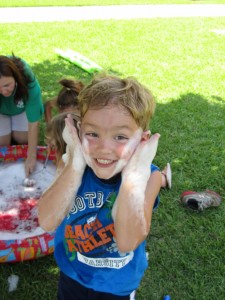 Chances are, if you have ever volunteered with a youth program, you have run into some children who have challenged you with their behavior. Earlier this month, Dr. Kate Fogarty and Sarah Hensley shared some insight and tips for disciplining children in a positive and productive way. The word discipline often has a negative connotation, but the origin of the word is “disciple” which means pupil, student, or apprentice. As a volunteer leader, your role is that of a guide- guiding youth towards acceptable behavior. Discipline, or guidance, is a corrective process to teach youth how to solve their problems rather than punishing them for problems they cannot solve.
Chances are, if you have ever volunteered with a youth program, you have run into some children who have challenged you with their behavior. Earlier this month, Dr. Kate Fogarty and Sarah Hensley shared some insight and tips for disciplining children in a positive and productive way. The word discipline often has a negative connotation, but the origin of the word is “disciple” which means pupil, student, or apprentice. As a volunteer leader, your role is that of a guide- guiding youth towards acceptable behavior. Discipline, or guidance, is a corrective process to teach youth how to solve their problems rather than punishing them for problems they cannot solve.
Here are three tips to remember when working with youth:
- 1. Say “Do” as an alternative to “Don’t.” Examples include:
- “Please use an inside voice during our club meeting. During recreation we will be outside and you can be loud then” instead of “Stop yelling!”
- “Can you tell me what is going on, taking turns?” instead of “Stop fighting!”
- “If you run through the woods, you could get hurt or miss seeing something really interesting” instead of “Don’t run through the woods!”
2 . Use encouragement rather than praise. Encouragement is specific and avoids comparison or competition between youth whereas praise is often vague and can foster competition. Research shows that praise can often lower self-esteem or reduce youth’s motivation for participation in an activity. Here are some examples:
| Praise | Encouragement |
| I like your photo | Tell me about your photo… |
| I like the way Jennifer is cleaning up | I appreciate how Jennifer helped put the art supplies away after the meeting. It really made my job as a leader easier. |
| You did a great job on your demonstration | How do you feel about your demonstration? |
| You clearly deserved a blue ribbon | How do you think your record book measured up with the judging standard? |
| You have what it takes to be a great leader | I have seen so much growth in your leadership skills, especially your ability to make good decisions and solving problems. |
- Set limits and consequences– we set limits to prevent injury to self or others and/or prevent property damage. Limits should be firm, but not strict and should be set with confidence and consistency. The key is following through with the consequences and explaining to the youth how their actions affect others. Examples:
- “If you continue to interrupt our guest speaker, you will have to find a different activity. The other members cannot hear and they want to learn about what horses eat.”
- “If you can’t remember to aim your arrow at the target, you will have to sit out for the next round of shooting. We do not want anyone to get hurt.”
- “If you cannot share, you will lose your turn because everyone wants a chance to play this game just as much as you do.”
Ultimately, the support 4-H volunteers provide youth to develop comes from a sense of safety, belonging, mastery, independence and generosity. There is a UF/IFAS Extension publication from our 4-H Volunteer Training Series on positive discipline for youth http://edis.ifas.ufl.edu/pdffiles/4H/4H34100.pdf. It provides explanations for youth misbehavior (or mistaken behavior) and non-verbal as well as verbal strategies for handling those common issues that come our way working in the field of youth development. To learn more about managing difficult behavior in a positive way, you can view the full, 1-hour workshop online at http://florida4h.org/madmondays.
- Meet our Summer Intern- Andy Franklin! - June 13, 2025
- Blue Ribbon Baked Goods - September 23, 2024
- Blue Ribbon Photos and Posters - September 21, 2024
